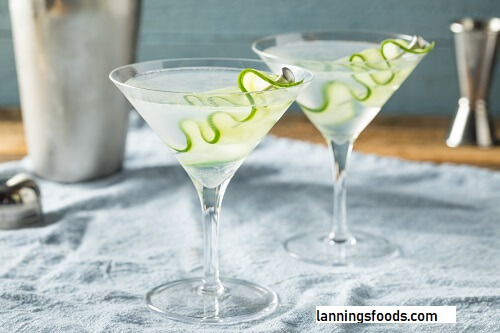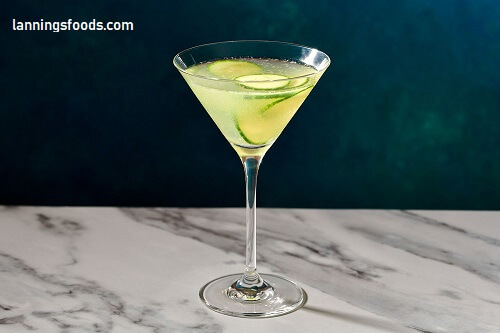Cucumber Martini Recipe
This fresh, cold cucumber martini is bursting with cucumber taste. To make it, muddle some crisp, fresh cucumbers and shake them with vodka and vermouth (or gin, if you like). This lets the delicate melon notes of the cucumber come through and nicely counterbalance the alcohol.
Depending on the capacity of your cocktail shaker, you can easily quadruple or treble this recipe, even though it only yields one cocktail. Instead of trying to make a big quantity where the ingredients won’t be well shaken, it is better to combine little amounts at a time.

Methods for Chopping and Slicing Cucumbers for a Martini:
Cucumber Martini Recipe:
Cucumbers are easy to chop for martinis. There’s no need to peel them; just cut them into slices with a sharp knife. One cocktail requires three large slices for muddling and a few little slices for garnish. To extract the fluids and flavor from the cucumbers, muddle them after they have been sliced. Using a wooden spoon or muddler, press down on the cucumber slices, giving the object or spoon a half turn for each downward press.
Instructions:
Cucumber Martini Recipe:
Crush three cucumber wheels with a muddler into a cocktail shaker. Stir in the sugar, vermouth, vodka, bitters, and ice. Shake well, and then serve into a chilled cocktail glass. Garnish with the remaining cucumber wheel. At SAVEUR, it’s safe to say that we’re obsessed with French butter. Whether it is wrapped around a crisp French morning radish, layered between sheets of pastry dough, or mixed into a sauce and served over pan-seared fish, nothing quite compares to its rich and delicious flavor.
Cucumber Martini Recipe:
We usually prefer French European butter because of its high fat content and distinct flavor depth, which is enhanced by the culture, as quality matters. Butter is essentially an emulsion of fat and water; most butter produced domestically has little more than 80% fat. French butter, on the other hand, has a minimum of 82% and a maximum of 85%. Even though the change seems small, the richness has changed.
That, along with the slightly tart umami flavor from culturing (a process in which the cream is fermented in advance), explains why it’s common for the French to spread it like cheese on toast (a habit we heartily endorse).

Brûlé manié thickens soups and stews quickly:
Cucumber Martini Recipe:
“Butter by hand” or “kneaded butter,” as it is also known, is called beurre manié. It is a simple and quick addition to soups, stews, and sauces. It is prepared in a similar way to a roux, except that equal parts butter and flour are kneaded to make a paste, which can be whisked into a boiling liquid to provide a velvety texture and richness without altering the flavor.
(When cooking, it’s common to use unsalted French butter to avoid accidentally oversalting your cuisine.) Beurre manié is a great tool for correcting soups or sauces that seem a little thin at the end of cooking, or for smoothing out pan juices into a silky sauce.
Chef Rollie Wesen of Johnson & Wales University and executive director of the Jacques Pépin Foundation says, “the cool thing about beurre manié is how flexible it is.” “I’ll create beurre manié at home using half a pound of butter, form it into small nuggets, and freeze them in a Ziploc.
He goes on. If I only need a small amount—maybe to thicken a pan sauce for some chicken breast or fish—I can skip the full process. It may be just taken out of the freezer and popped into the pan.
Use beurre blanc to brighten and elevate seafood and vegetables:
Cucumber Martini Recipe:
Beurre blanc, also known as “white butter,” is a classic French sauce that is highly appreciated for its well-balanced acidic and creamy notes. This buttery sauce, which is emulsified with shallots, white wine, and sometimes vinegar (depending on the chef), complements fish and vegetables wonderfully.
According to Wesen, butter is fundamentally an oil-and-water emulsion. The composition of French-style butter is 82–85% fat, 2–5% milk proteins, and water softly suspended in a spreadable, smooth emulsion. Wesen says you do the opposite with beurre blanc. Oil in water emulsification is the term for it. When you add butter to a reduction of wine and aromatics, one pat at a time, you want the reduction to be very thick and have very little moisture. According to him, “You want to start with the smallest amount of water possible in the pot to give your beurre blanc a thick and luxurious viscosity because your butter is bringing 10 to 15 per cent water with it.”
Cucumber Martini Recipe:
Chef Robin Hollis of the Post House in Charleston, South Carolina, upgrades her beurre blanc dish with champagne instead of white wine, saying, “We swap out the vinegar for lemon juice, too, for a mellower acidity,” and serves it over an egg yolk raviolo garnished with a generous dollop of caviar.

Use beurre noisette to give sauces and desserts a toasted touch:
The most well-known of the three is probably beurre noisette, which translates to “hazelnut butter” and is named for its nutty colour and aroma. The technique highlights the milk solids in the butter, which caramelises to a deep brown and gives it a deliciously toasty flavour that is perfect for sauces and baked goods.
Recipe for Cucumber Martini:
Once the water has been completely evaporated from melted butter, all that is left are fat and the residual milk proteins, which start to caramelize right away. “Nothing can be brown until all the water is gone,” claims Wesen. He keeps going, “The maximum temperature you can reach is 212 degrees Fahrenheit as long as there’s water in there.” 280 degrees Fahrenheit is the temperature at which browning reactions start. The butter is sizzling and water is still evaporating.